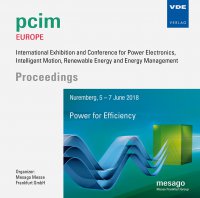High Temperature Encapsulation for Smart Power Devices
Conference: PCIM Europe 2018 - International Exhibition and Conference for Power Electronics, Intelligent Motion, Renewable Energy and Energy Management
06/05/2018 - 06/07/2018 at Nürnberg, Deutschland
Proceedings: PCIM Europe 2018
Pages: 5Language: englishTyp: PDF
Personal VDE Members are entitled to a 10% discount on this title
Authors:
Becker, Karl-Friedrich; Obst, Mattis; Bauer, Joerg; Braun, Tanja (Fraunhofer Institute for Reliability and Microintegration, Germany)
Thomas, Tina; Schneider-Ramelow, Martin; Lang, Klaus-Dieter (Technical University Berlin, Microperipheric Center, Germany)
Abstract:
During the last years within power electronics packaging a trend towards compact power electronics modules for automotive and industrial applications could be observed, where a smart integrated control unit for motor drives is replacing bulky substrates with discrete control logic and power electronics. Most recent modules combine control and power electronics yielding maximum miniaturization. Transfer molding is the method of choice for cost effective encapsulation of such modules due to robustness of the molded modules and moderate cost of packaging. But there are challenges with this type of package: Typically, those packages are asymmetric, a substrate with single sided assembly is overmolded on the component side and the substrate backside is exposed providing a heat path for optimized cooling. This asymmetric geometry is prone to yield warped substrates, preventing optimum thermal contact to the heatsink and also putting thermomechanical stress on the encapsulated components, possibly reducing reliability. As such packages are truly heterogeneous, combining powerICs, wire bonds, SMDs, controlICs, substrate and leadframe surfaces, the encapsulant used needs to adhere sufficiently to all different surfaces present. Additionally those packages need to operate at elevated temperatures for long time, e.g. operate at 200 °C for 1000 h and more, so high thermal stability is of ample importance. At Fraunhofer IZM the development of processes for the encapsulation of such modules is well within the focus of various research projects – but behind the mere process & package development ideally yielding homogeneously encapsulated power packages without voiding and delaminations lies the issue of long term reliability at elevated temperatures. During the last years a systematic approach to evaluate bulk material stability of dielectric materials at temperatures up to 250 °C has been followed, combining thermomechanical analysis determining degradation temperature, CTE, Young’s modulus and glass transition temperature Tg. But also dielectric behavior over time and storage temperature have been investigated, yielding dielectric strength, dielectric constant and loss factor for encapsulants. Additionally mechanical properties as adhesion strength on leadframe and ceramics is determined to identify interfacial behavior of these materials. Summarized a description of the high temperature suitability testing of encapsulants for power electronics encapsulation is provided – additionally an extended test methodology is described to facilitate future material evaluation for HT or harsh environment use of polymeric materials as encapsulants or base materials.


